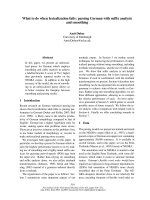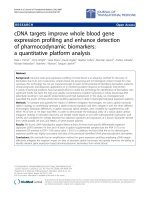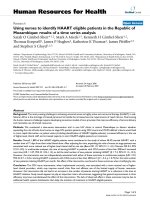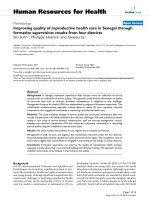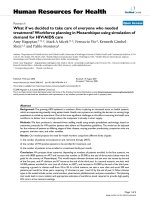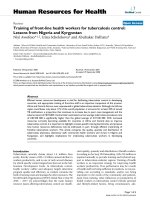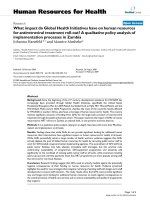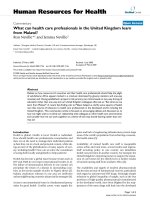báo cáo sinh học:" What impact do Global Health Initiatives have on human resources for antiretroviral treatment roll-out? A qualitative policy analysis of implementation processes in Zambia" pptx
Bạn đang xem bản rút gọn của tài liệu. Xem và tải ngay bản đầy đủ của tài liệu tại đây (233.98 KB, 9 trang )
BioMed Central
Page 1 of 9
(page number not for citation purposes)
Human Resources for Health
Open Access
Research
What impact do Global Health Initiatives have on human resources
for antiretroviral treatment roll-out? A qualitative policy analysis of
implementation processes in Zambia
Johanna Hanefeld*
1
and Maurice Musheke
2
Address:
1
Health Policy Unit, London School of Hygiene and Tropical Medicine, University of London, London, UK and
2
Zambia HIV related TB
project (Zambart), University of Zambia, Lusaka, Zambia
Email: Johanna Hanefeld* - ; Maurice Musheke -
* Corresponding author
Abstract
Background: Since the beginning of the 21
st
century, development assistance for HIV/AIDS has
increasingly been provided through Global Health Initiatives, specifically the United States
Presidential Emergency Plan for AIDS Relief, the Global Fund to Fight HIV, TB and Malaria and the
World Bank Multi-country AIDS Programme. Zambia, like many of the countries heavily affected
by HIV/AIDS in southern Africa, also faces a shortage of human resources for health. The country
receives significant amounts of funding from GHIs for the large-scale provision of antiretroviral
treatment through the public and private sector. This paper examines the impact of GHIs on human
resources for ART roll-out in Zambia, at national level, in one province and two districts.
Methods: It is a qualitative policy analysis relying on in-depth interviews with more than 90 policy-
makers and implementers at all levels.
Results: Findings show that while GHIs do not provide significant funding for additional human
resources, their interventions have significant impact on human resources for health at all levels.
While GHIs successfully retrain a large number of health workers, evidence suggests that GHIs
actively deplete the pool of skilled human resources for health by recruiting public sector staff to
work for GHI-funded nongovernmental implementing agencies. The secondment of GHI staff into
public sector facilities may help alleviate immediate staff shortages, but this practice risks
undermining sustainability of programmes. GHI-supported programmes and initiatives add
significantly to the workload of existing public sector staff at all levels, while incentives including
salary top-ups and overtime payments mean that ART programmes are more popular among staff
than services for non-focal diseases.
Conclusion: Research findings suggest that GHIs need to actively mediate against the potentially
negative consequences of their funding on human resources for health. Evidence presented
highlights the need for new strategies that integrate retraining of existing staff with longer-term staff
development to ensure staff retention. The study results show that GHIs must provide significant
new and longer-term funding for additional human resources to avoid negative consequences on
the overall provision of health care services and to ensure sustainability and quality of programmes
they support.
Published: 10 February 2009
Human Resources for Health 2009, 7:8 doi:10.1186/1478-4491-7-8
Received: 26 August 2008
Accepted: 10 February 2009
This article is available from: />© 2009 Hanefeld and Musheke; licensee BioMed Central Ltd.
This is an Open Access article distributed under the terms of the Creative Commons Attribution License ( />),
which permits unrestricted use, distribution, and reproduction in any medium, provided the original work is properly cited.
Human Resources for Health 2009, 7:8 />Page 2 of 9
(page number not for citation purposes)
Background
There is a shortage of human resources for health (HRH)
throughout sub-Saharan Africa [1]. Many countries in the
region are also experiencing significant HIV epidemics,
with an estimated 2.12 million persons needing antiretro-
viral medicines [2]. The lack of adequate human resources
for health directly affects countries' ability to provide
antiretroviral treatment to their population [3]. The dis-
ease burden of HIV and HIV-related mortality among
health sector staff has further reduced human resources
[4], at a time when the introduction of antiretroviral treat-
ment in the public health system has substantively
increased the workload of staff [5] and created an urgent
need for additional human resources [6,7].
Strategies to address human resource deficits have centred
around staff retention (through incentives such as allow-
ances, salary top-ups, and better working conditions) and
retraining, including shifting as many tasks as possible
away from doctors, nurses and pharmacists to non-clini-
cal staff, enabling clinical staff to concentrate on their spe-
cific areas of expertise [3,5,7]. In Malawi for example,
where special attention has focused on addressing the
shortage of human resources for health, all health sector
workers have received a salary top-up to increase staff
motivation, financed by funding provided to the
Malawian Ministry of Health [8].
Many of the countries heavily affected by HIV and AIDS,
which are facing a human resource crisis, are receiving
large amounts of donor funding, including support for
the large-scale provision of antiretroviral treatment
through the public sector and private sector. Since the
beginning of the 21
st
century, development assistance for
HIV and AIDS has increasingly been provided through
partnerships and Global Health Initiatives (GHIs), specif-
ically the United States Presidential Emergency Plan for
AIDS Relief (PEPFAR), the Global Fund to Fight HIV, TB
and Malaria and the World Bank Multi-country AIDS Pro-
gramme [9].
Evidence of the impact of GHI programmes on human
resources at country level, especially at subnational level,
is limited. However, some studies have examined their
impact in Ethiopia [10], and in Uganda, Mozambique
and Zambia [11,12], and research findings are forthcom-
ing from studies in Malawi and other countries[13].
This paper examines the impact of GHIs on human
resources for ART roll-out in Zambia, at national, prov-
ince and at micro level in two districts. The focus is on
GHI's ability to contribute to retain and retrain staff, and
also on unintended consequences of their programmes
on human resources for health.
Methods
The paper draws on more than 90 in-depth interviews
with policy-makers and implementers at national and
subnational level, engaged in processes governing the
implementation of ART roll-out. Actors interviewed
include national, provincial and district representatives
from government institutions; the donor community;
governmental and nongovernmental service providers;
doctors and nurses; NGOs supporting the roll-out; pro-
gramme managers; community workers; and networks of
people living with HIV/AIDS.
Interviews were conducted in Zambia between August and
December 2007, as part of wider, comparative research on
policy processes relating to the implementation of ARV
roll-out at national, provincial and district level. Inter-
views were conducted at national level, as well as at pro-
vincial level in one province, and district-level research
was conducted in two districts within the focus province.
Interviewees were selected based on a "snowballing" proc-
ess originating from an in-country advisory panel, made
up of academics, representatives of nongovernmental
organizations, a Zambian clinician and a representative of
a network of people living with HIV/AIDS.
Interviews were semistructured and used an interview
guide that was tested and revised in consultation with the
in-country advisory panel. Actors were interviewed about
their perception of implementation processes relating to
ART roll-out, as well as their role and personal history in
relation to these processes. Where permission was
granted, interviews were recorded and transcribed; other-
wise extensive notes were taken.
A subset of 32 interviews was selected for this paper in
which interview content focused on both GHIs and
human resources. Interviews were analysed to identify five
key themes identified: training, "top-ups", mentoring,
coordination and recruitment of staff.
The research conducted is qualitative, so relies on, and is
limited to, the perceptions of persons interviewed at
national level, in one province and two districts, who are
working in the ART roll-out and interacting with GHIs reg-
ularly in their work. To better understand the perceptions
of actors at different levels, the results and discussion sec-
tion highlight at which level – national, province or dis-
trict – interviewees operate.
Where possible, the paper draws on available secondary
research and data on human resources obtained by the
authors during the research, allowing for validation of
data collected. Given the recent, unfolding nature of the
ART roll-out, and the limited secondary data available,
this paper provides an empirical, contemporary spotlight
Human Resources for Health 2009, 7:8 />Page 3 of 9
(page number not for citation purposes)
on an underresearched and changing area. The research
for this paper was conducted as part of a "twinning"
project between a Zambian researcher and a UK
researcher. Ethical clearance for the research was granted
by the ethics committees of the University of Zambia and
the London School of Hygiene and Tropical Medicine.
Results and discussion
Human resources for health in Zambia
Zambia faces a severe shortage in human resources, exac-
erbated by the country's HIV epidemic – an estimated 1.2
million (17%) Zambians are currently living with the
virus – with less than a third of the recommended doctor-
patient ratio [14] to treat the population. But the shortage
of human resources for health is not limited to doctors,
nor are they in the shortest supply. The greatest need is for
laboratory technicians, followed by pharmacists, doctors,
nurses and data monitors [interview, national level,
November 2007].
Other problems have also been identified. For example,
there is a rapid turnover of staff, high staff absenteeism
[15] and an unequal distribution of staff between rural
and urban areas [16,17]. Ministry of Health data revealed
that in 2006, 368 staff members joined the public health
sector, while 380 left the sector, highlighting a continued
loss [15]. The main causes of attrition of health workers in
2004 were death and resignation of workers from the
health service [16]. High vacancy rates of health posts
throughout the public sector are well documented
[14,15].
The human resource crisis is particularly urgent in relation
to the ART roll-out, given the complexity of ART. Medi-
cines need to be taken daily for the remainder of a per-
son's life, and patients need to be initiated on the
medication and reviewed on a regular basis by a doctor.
Patients are also counselled by either a lay counsellor or a
nurse on the importance of adherence to the treatment
regime and a healthy lifestyle, while drugs need to be
ordered and administered by a pharmacist. Despite the
constraints, Zambia has had remarkable success in scaling
up access to ART in the public sector. Between 2003 and
the end of 2007, more than 130 000 persons were initi-
ated on antiretrovirals out of 250 000 to 300 000 who are
estimated to need such medication [interview, national
level; October 2007].
To address the shortfalls in human resources, the Zam-
bian government developed a specific human resources
strategy in 2005, which has since received support from
different donors. At the time this research was conducted,
however, the only targeted human resource intervention
receiving donor support, including through PEPFAR fund-
ing, was the rural retention scheme. This includes incen-
tives to attract doctors into rural areas, including better
housing, a car and a cash allowance [14].
GHIs in Zambia
Zambia receives significant amounts of funding for its
HIV programme from three Global Health Initiatives: the
United States Presidential Emergency Plan For AIDS Relief
(PEPFAR); the Global Fund to Fight AIDS, TB and Malaria;
and the World Bank Multi-country AIDS Programme
(MAP). In 2006 PEPFAR money alone made up 63% of all
funding for HIV in Zambia [18]. This was in addition to
resources for HIV from the World Bank MAP and the Glo-
bal Fund.
However, mapping the flow of funding provided by indi-
vidual GHIs in support of the public ART treatment pro-
gramme is difficult[19]. This is in part because much of
the funding supporting public sector programmes is chan-
nelled through NGOs or other private institutions and not
directly to the government. For example, a recent study
revealed that less than 5% of all PEPFAR funding for Zam-
bia in 2005 was received by the government [19]. In some
cases it is difficult to differentiate expenditure between
intervention areas, such as treatment, prevention or care.
Data on actual expenditure, i.e. funding disbursed to
recipients at the country level, is also not easy to obtain,
since PEPFAR and the World Bank MAP, for example, do
not publicly share this information [18].
Despite the limitations in detailed information, broad
information on funding was obtained. Interviews with
key stakeholders confirmed that the preponderance of
funding for treatment roll-out in the public sector is
through GHIs, even if this is provided in the form of tech-
nical support and not direct funding to the government.
Through consulting recent planning documents, a Minis-
try of Health official responsible for planning the ART
roll-out for 2008–2009 expected "50% to 52% of funding
from PEPFAR, 34% from the Global Fund and 10% to
15% or so from other sources" [interview, national level,
November 2007].
PEPFAR funding is not allocated through the Ministry of
Health but instead to US and national subrecipients, who
then provide a range of support for prevention, care and
treatment to facility, district and provincial level. PEPFAR
subrecipients are mainly NGOs, (but also academic, pri-
vate sector and government institutions) and, as they
essentially implement the PEPFAR programme, they are
also referred to as PEPFAR implementers. The impact and
forms of this support concerning human resources, specif-
ically support provided for treatment roll-out, are
explored later.
Human Resources for Health 2009, 7:8 />Page 4 of 9
(page number not for citation purposes)
The World Bank MAP grant, while in part envisaged to
support the Ministry of Health's procurement of ART [20],
in practice supported other elements of the programme,
including laboratory supplies [interview, national level,
November 2007] [18]. Global Fund resources are directly
received by the Ministry of Health and at the time of con-
ducting this research were paying for the actual ARV med-
ication.
The study focus province and district
The shortage of human resources for health was evident in
the two study districts. At the time of conducting this
research, six public sector clinics in one of the focus dis-
tricts provided treatment to a population of 363 734 (GRZ
2000) with a staff of three doctors, one pharmacist and a
changing number of technical (also called clinical) offic-
ers and nurses. In the second focus district, with a popula-
tion of about 450 000, two doctors rotated between five
clinics providing ART. Since 2004 more than 4000 people
have started ART in each of the two districts, in clinics run
by the district, with no additional staff provided by the
Ministry of Health for these services.
In the study focus districts and province, public sector
roll-out of ART was supported by one PEPFAR implement-
ing agency, while additional PEPFAR support was pro-
vided for a private hospital in one of the districts. Funding
to the Ministry of Health for actual medication and labo-
ratory equipment aside, World Bank MAP and Global
Fund support in the study districts and province focused
on non-clinical interventions. In terms of supporting the
clinical treatment roll-out at subnational level, PEPFAR
implementers emerged as the most visible presence dur-
ing the period of this research.
GHI's addressing the human resources for health shortage
While GHIs do not provide direct financial support for
additional human resources in the public sector, their
programmes address the shortage in human resources
through training for health care workers and volunteers in
all aspects required to support the treatment programmes.
They also provide allowances such as overtime payments,
"top-ups", or payments of expenses, especially for volun-
teer counsellors or treatment support workers.
PEPFAR-funded programmes also provide ongoing men-
toring or technical support in health facilities. This refers
to clinical staff employed by a PEPFAR implementing
organization who support health facilities, such as clinics
or hospitals, on a regular basis (for example, through vis-
its about once a week) to discuss issues relating to the
treatment programme. They assist with questions relating
to clinical management of patients. The exact models for
technical support vary. Some PEPFAR organizations have
staff based at provincial level, others send support teams
from the capital on a regular basis.
In addition, PEPFAR implementers pay for, or second,
data entry clerks in health facilities they support. These
clerks record the number of persons who receive ART.
Data are reported to both the Ministry of Health and PEP-
FAR. Similarly, clinical care specialists have been
employed by a PEPFAR-funded organization and sec-
onded to the provincial health directorates in each of
Zambia's nine provinces.
While each of these interventions aims to alleviate the
human resource shortage in relation to ART, examining
their impact at district and provincial level in detail sug-
gests possible negative, unintended consequences. The
following discusses each of these interventions in turn,
based on the evidence emerging from interviews with key
stakeholders.
"Top-ups": the impact of incentives for health workers in
ART delivery
PEPFAR-implementing organizations provide "top-ups"
to public health care workers and community volunteers
working on the ART programmes they support. "Top-ups"
are either overtime payments for shifts worked in the ART
clinic or transport costs for meetings for those working on
PEPFAR-funded health programmes. These incentives go
a long way in motivating public health workers to work in
the ART clinic. All nurses interviewed as part of this
research confirmed that among their colleagues the ART
clinic is the most popular [interviews, district level, Octo-
ber and November 2007], and their enthusiasm was ech-
oed by the observations of policy-makers that ARV clinics
or programmes are liked by staff.
While this suggests that "top ups" are successful in moti-
vating staff to work on the ART programme, it raises con-
cerns about possible unintended consequences. A recent
study conducted among health care workers in three Zam-
bian districts found that on average only 7% of health
workers who had delivered non-HIV services had received
incentives, underlining the clear financial benefits arising
from involvement in ART delivery and causing imbal-
ances between different parts of the service [11].
Some interviewees were concerned about the distorting
effect of such payments, diverting attention and resources
from non-focal diseases [interview, national level, Octo-
ber 2007]. Evidence collected was not clear on whether or
not this is the case in the day-to-day delivery of services at
health facility level.
However, policy-makers and planners interviewed at
national level felt strongly that their work had focused
Human Resources for Health 2009, 7:8 />Page 5 of 9
(page number not for citation purposes)
largely on HIV and related diseases, to the neglect of other
equally urgent health issues. This may possibly be a reflec-
tion of the time and attention devoted at that level to
coordination of these activities. One senior Ministry of
Health official observed, "HIV, TB and malaria have taken
almost 90% of our time, not to mention that they have
also taken most of our budgetary money to the extent that
we have actually neglected what we call noncommunica-
ble diseases" [interview, national level, October 2007].
The provision of short-term incentives such as top-ups
may also have implications for sustainability, including
quality of care. Speaking about the effect on the quality of
care in the longer term, a senior Ministry of Health official
explained: "They [donors] support short-term incentives
but those are highly unsustainable because they are
applied for a year. You put so many people on treatment
because you are providing services to the health worker,
then the following year there is nothing " [interview,
national level, November 2007].
What this official points to is the effect of the one-year
funding cycle of PEPFAR, which means that incentives
cannot be guaranteed beyond that time frame, which may
create resentment among existing staff members, who
narrowly miss out on receiving top-ups or change their
performance from year to year. There may also be a nega-
tive impact on long-term quality of care if top-ups are
withdrawn after a year, and this underlines concerns
about sustainability of the programmes. An advisor to the
Ministry of Health said: "They [GHIs] are going to leave
everything flat when they leave" [interview, national level,
November 2007].
This suggests that while top-ups or incentives are success-
ful in motivating existing health care workers to work in
the ARV clinics, they may have negative immediate conse-
quences on attention paid to the quality of care provided
to non-focal diseases. This echoes findings on the impact
of top-ups by Ooman et al. [12]. As top-ups are not sus-
tainable beyond the period funded by a GHI, it also raises
concerns about the ability to sustain quality of care for
patients in the longer term.
Training and mentoring of health care workers for ART
provision in Zambia
One of the key GHI elements of support is training for
health care workers. As a clinician from a PEPFAR imple-
menting organization described their strategy: "We put
money into doing additional training for clinical officers,
medical officers and if their sites are growing rapidly and
they need additional training, the team goes and assesses
the needed training" [interview, national level, October
2007].
The training helps build capacity of health care workers
involved at different levels in the provision of ART. How-
ever, health care workers often leave the public sector or
their position once they are trained. All PEPFAR imple-
menting agencies supporting the ART roll-out in Zambia
described this as a common experience and a key chal-
lenge. A senior district health official replied, when asked
about the greatest challenge faced in implementing the
ART roll-out: "human resources you train people to pro-
vide this and within a short time they have left. So you
need to find people to continue providing the service.
That has been a major challenge in terms of implement-
ing " [interview, district level, September 2007]. The very
fast turnover of staff once trained suggests that external
training, in isolation from increased resources to enable
career progression and longer-term incentives in the pub-
lic sector, has little effect in alleviating the shortages of
skilled health care workers to support the provision of
ART.
In addition, training, especially the per diems provided
during such training, are part of the reasons that attract
health workers to work on the ART programme, adding to
the potentially distorting effects of top-ups. A further con-
sequence of training, when externally conducted, means
that these are short-term, intensive courses that take clini-
cians out of their clinic, imposing a further strain on the
day-to-day running of the ART programme.
Mentoring and the secondment of GHI staff to the public
sector
In addition to training, the PEPFAR implementing organ-
izations in Zambia supporting ART roll-out provide ongo-
ing technical support through mentoring of health care
workers. This involves visiting ART sites and attending to
patients together with health care staff, to monitor the
quality of services and assist with difficult clinical cases.
Some organizations have teams of specialists, ranging
from clinical care to pharmacy, nursing and logistical sup-
port, who visit the clinics and hospitals supported by their
organization on a monthly or weekly basis.
In some cases, technical support is provided by staff
recruited and employed by a PEPFAR implementing
agency and seconded to the public health sector, where
they work alongside their public sector colleagues. An
example of this practice is the PEPFAR-funded Health
Services and Systems Programme (HSSP), aimed at pro-
viding technical support to the Ministry of Health. It
focuses on aspects relating to the health systems and
human resources.
As part of its support, HSSP recruited and seconded clini-
cal care specialists to each of Zambia's nine provincial
health directorates, to provide technical support to the
Human Resources for Health 2009, 7:8 />Page 6 of 9
(page number not for citation purposes)
districts and hospitals in the delivery of ART services [Abt
Associates, 2007]. These clinical care specialists work in
the provincial health directorate alongside a clinical care
specialist employed by the Ministry of Health, but receive
a higher salary. While part of the provincial health team,
they also have access to a small operational budget for
training and ongoing support [interview, national level,
October 2007]. All nine clinical care specialists employed
by HSSP are physicians, whereas the government's coun-
terparts are nurses or technical or clinical officers (holders
of a three-year, diploma-certified degree that in Zambia
allows clinical practice).
While these clinical care specialists are in addition to the
provincial team and undoubtedly contribute through
their skills and commitment, given the salary level and
remit, these posts are not sustainable beyond HSSP fund-
ing. In addition, their relative seniority compared to the
government's clinical care specialists raises questions
about working (and status) relationships that may affect,
both positively and negatively, the implementation of
services. Some national actors reported that the clinical
care specialists had led to an increase in capacity, while
implementers at provincial and district level reported that
their engagement may have led to demotivation of gov-
ernment staff. In addition, interviews suggested that
nurses and technical officers at district level referred to the
MoH clinical care specialist, whereas doctors worked with
the HSSP-employed clinical care specialist.
Increasing workload through coordination
Despite efforts at national level to coordinate activities
between the different implementing partners and the
Zambian government through a range of bodies, includ-
ing technical committees that determine a geographical
and skills-based division of labour, policy-makers inter-
viewed mentioned that coordination with individual
organizations remained problematic. A senior official at
the Ministry of Health said: "In Lusaka alone there are
close to 236 partners working on HIV to track what they
are doing is a challenge" [interview, national level,
November 2007]. When describing the coordination,
another Ministry of Health official said: " it is over-
whelming, there is a lot that needs to be done and some-
times I feel as if am doing injustice to some of the
activities" [interview, national level, November 2007].
There is clear evidence, from the data collected and other
research focusing on human resources and ART, that the
workload for staff has increased since the introduction of
ART [4]. In one study district, the same number of doctors
and nurses as in 2004 (before district provision of ART)
were providing treatment and care to more than 4000
patients on ART by the end of 2007 [interview, district
level, October 2007]. As previously highlighted, the dis-
trict staffing levels at the time of conducting this research
were two and three doctors in clinical care, respectively, in
the focus districts, and approximately 10 members of staff
at the provincial health administration. Health care work-
ers interviewed said that their workload had not only
increased due to a greater number of patients, but also due
to coordination of activities funded or implemented by
GHIs.
At province and district level, the coordination with PEP-
FAR implementers posed an additional workload for
health sector staff, due to funding requirements. Districts
supported by PEPFAR in their roll-out were required to
provide monthly reports to the provincial office of the
PEPFAR implementer. These were in addition to quarterly
reports that form part of the Ministry of Health processes
and the MoH's twice-annual performance reviews.
To streamline the process and avoid confusion, each dis-
trict in the province had appointed a focal person to inter-
act with PEPFAR implementers [interview, district level,
October and November 2007]. Focal persons were drawn
from among doctors, nurses and clinical officers working
at the district level.
PEPFAR implementers held quarterly meetings with sup-
ported districts to review activities. In addition, PEPFAR
implementers supported the district teams to have further
regular meetings, to either coordinate with other stake-
holders, such as NGOs, or to discuss issues of clinical
management.
While PEPFAR implementers provided resources for these
meetings, their organization and arrangements are the
responsibility of the district focal person, in addition to
his or her clinical workload. The rationale for making this
a district responsibility was to ensure that the district man-
aged the programmes in an integrated way. However,
there were opportunity costs to district staff – such as
time. Meetings tended to last a whole working day. As one
district staff pointed out: "Our work has increased, like
when it comes to meetings, I have to write the memos, to
contact people we have about three meetings in a month
clinical meeting, quarterly review meeting and the quar-
terly referral meeting – which usually take the whole
day " [interview, district level, November 2007].
Many new initiatives instigated and supported by GHIs,
including through financial resources for training and
materials, must be implemented at existing staff level. An
example of this is the introduction of ART site accredita-
tion, introduced with the technical assistance of a local
PEPFAR implementer who helped develop a standard set
of indicators against which to assess sites' readiness to be
accredited to have minimum requirements in place, for
Human Resources for Health 2009, 7:8 />Page 7 of 9
(page number not for citation purposes)
the provision of ART. The Zambian Medical Council has
been designated to oversee the process, receiving a mini-
mal budget for overseeing and facilitating the accredita-
tion process, by use of existing funds for monitoring and
evaluation [interview, national level, November 2008].
At provincial level, the accreditation of sites, which
involves a site visit and assessment, is conducted through
teams that draw on existing provincial health administra-
tion staff (10 persons) and medical practitioners from the
provincial hospitals. By mid 2007, more than 30 sites
were already providing ART in the focus province, and as
accreditation of sites was introduced several years after the
start of the public sector ART programme, these sites
needed to be assessed. This was in addition to any new
sites for ART roll-out [interview, district level, October
2007].
Accreditation requires a site visit and assessment. Given
staffing levels, with no additional human resources avail-
able for the accreditation processes these were under-
standably delayed [interview, national level, November
2008]. While site accreditation is undoubtedly an impor-
tant element of quality assurance, the way in which this
was introduced, and its implementation envisaged, shows
the limitations of such initiatives in the absence of addi-
tional funding for human resources.
This suggests that support by GHIs, particularly PEPFAR
implementers, is provided in the form of training and
financial support for materials and meetings, for many
new initiatives that may improve the ART programme and
ensure greater quality of care and treatment. Despite the
clear benefits of the intended outcomes, the lack of fund-
ing for additional human resources within the health sec-
tor adds significantly to the workload of already stretched
human resources for health, risking further burnout and
ultimately contributing to making programme efforts less
sustainable.
GHI recruiting
A further impact of GHIs on human resources for health
is the actual recruitment of health workers from within
the public sector, by the various implementing agencies of
GHIs, especially those funded through PEPFAR. This is
particularly apparent in the support provided for a clinical
intervention, such as the provision of ART roll-out, where
assistance, including training and mentoring, requires cli-
nicians familiar with the Zambian health system.
Of 15 health workers (including doctors, nurses and phar-
macists) currently working for GHIs or their implement-
ers who were interviewed for this study, nine had recently
been recruited from the public sector. One senior Ministry
of Health official described how PEPFAR agencies recruit
government employees once they have gained experience,
and then describe the government as lacking capacity: "It
[PEPFAR] is strategically weakening government
efforts What is happening is that we are training people
next you will hear that he has been taken next you will
hear that government, you have no capacity" [interview,
national level, December 2007].
Of the health workers involved in the two public sector
sites that started ART in Zambia in 2002 (University
Teaching Hospital, Lusaka, and Ndola Central Hospital),
including the doctors leading these programmes, the
majority have now left the public sector to work for GHI-
funded organizations that support the roll-out of ART
[interviews, national level; September-November 2007].
It appears that GHIs, by recruiting local health care work-
ers to provide the technical support for ART, are drawing
precisely from, and depleting the pool of, the most-quali-
fied health workers in Zambia. These findings corroborate
the practices observed in a three-country study by Ooman
et al. [12].
Conclusion
Global Health Initiatives have vastly expanded access to
life-saving treatment for thousands of people in Zambia,
yet they are not effectively addressing the human
resources for health shortages in their programmes sup-
porting ART roll-out. Given the overall amount of their
resources aimed at supporting ART programmes, compar-
atively little is being done to address the health worker
shortage. While some of their interventions, such as top-
ups for staff working on ART, secondment and training
appear to alleviate staff shortages in the short term, and
succeed in giving many health sector staff the opportunity
to improve their knowledge and skills on HIV/AIDS
through short term training, workshops and on-the job
training, they appear less successful at staff retention. This
echoes similar findings from three further districts in
Zambia recently published [11].
GHIs' programmes have increased the workload of
already-stretched managers and health care providers. As
the majority of GHIs, particularly PEPFAR, support treat-
ment through individual organizations, such as NGOs,
there is a significant added workload for public sector
health staff who have to coordinate these support activi-
ties. This appears to be the case at all levels from national
to district level, adding to potential problems of staff
burnout. The recruitment by GHIs of public sector health
workers to work for GHI-funded nongovernment imple-
menters that support public sector roll-out further reduces
the human resources for health in the public sector in
Zambia. It also raises concerns about the ethical dimen-
sion of this assistance, where instead of providing much-
needed resources to the government to increase human
Human Resources for Health 2009, 7:8 />Page 8 of 9
(page number not for citation purposes)
resources for health, development agencies use aid money
to hire public sector workers to provide external assistance
to the ART programme.
When recommending and supporting new policies, such
as site accreditation for ART, GHIs should conduct a
human resource impact assessment and address the
human resource needs created by such interventions
through additional funding that will allow the govern-
ment to recruit the staff required to implement them
through the public sector.
By not providing resources for the MoH to employ further
human resources, but seconding them, as in the case of
additional provincial clinical care specialists, additional
capacity remains external and limited to the period of GHI
funding available. The more Zambia's treatment pro-
gramme relies on mentoring and seconded staff, the less
sustainable it becomes in the long term, creating greater
dependence on GHIs to continuously fill these gaps in
capacity. Different approaches, such as the model fol-
lowed in Malawi, should be explored to avoid creating
further dependence [8].
Similarly, as training is provided through external part-
ners and not integrated into a longer-term strategy for
developing the human resources and allowing individuals
to progress professionally within the health system, there
are limited incentives for health professionals to remain
within the public health care system.
The impact of top-ups increases staff motivation and
interest in the ART programmes, but may have a distorting
effect on health services overall. There is concern that as
staff move vertically towards the ART programme, quality
of services for non-focal diseases may suffer. In addition,
the short-term nature of funding cycles may mean a drop
in quality of care for patients on ART, once these pay-
ments are discontinued. More research is needed to assess
the impact of top-ups for disease-specific programmes on
the overall provision of health care services.
These interventions, aimed at addressing the shortages in
human resources for health, including top-ups, mentor-
ing, secondment of staff and training, all appear "surgical"
in that they are not genuinely interwoven into the Zam-
bian health system at all levels. They could be removed or
abandoned, leaving a nearly hollowed-out treatment pro-
gramme behind.
The evidence discussed in this paper – from interviews
with Zambian health workers at all levels from the
national Ministry of Health to districts and clinics – sug-
gests that GHIs need to rethink the impact of their overall
programmes, policies and conduct in relation to human
resources for health. They need to address the long-term
effect on quality of care and health systems of interven-
tions targeted at alleviating staff shortages to avoid creat-
ing an ever-growing dependency of the Zambian
treatment programme on external actors.
Competing interests
The authors declare that they have no competing interests.
Authors' contributions
JH conceived the study and its design. MM and JH con-
ducted interviews jointly, and worked together on tran-
scribing and analysing data collected. They jointly
developed an outline for the paper and wrote the initial
draft, which they revised following comments from
reviewers. All authors have read and approved the final
manuscript.
Authors' information
Johanna Hanefeld is a PhD candidate at the London
School of Hygiene and Tropical Medicine, researching
policy implementation processes relating to ART roll-out
in Zambia and South Africa. Maurice Musheke is a social
scientist based at Zambart. This article is the result of a
"twinning" between the two researchers.
Acknowledgements
The authors acknowledge the contribution of Virginia Bond, Gill Walt and
Lucy Gilson. Research collaboration was supported by the Evidence for
Action research consortium at the London School of Hygiene and Tropical
Medicine, with funding from the Department for International Develop-
ment (DFID), United Kingdom.
References
1. Chen L, Evans T, Anand S, Boufford JI, Brown H, Chowdhury M,
Cueto M, Dare L, Dussault G, Elzinga G, et al.: Human resources
for health: overcoming the crisis. The Lancet 2004,
364:1984-1990.
2. UNAIDS W, UNICEF: Towards Universal Access 2008.
UNAIDS ed. Geneva; 2008.
3. WHO: Treat, Train, Retain – The AIDS and health workforce
plan. Report on the Consultation on AIDS and Human
Resources for Health, WHO, Geneva, 11–12 May, 2006.
Geneva 2006.
4. Dieleman M, Biemba G, Mphuka S, Sichinga-Sichali K, Sissolak D,
Kwaak A van der, Wilt G-J van der: 'We are also dying like any
other people, we are also people': perceptions of the impact
of HIV/AIDS on health workers in two districts in Zambia.
Health Policy Plan 2007, 22:139-148.
5. Van Damme W, Kober K, Kegels G: Scaling-up antiretroviral
treatment in Southern African countries with human
resource shortage: How will health systems adapt? Social Sci-
ence & Medicine 2008, 66:2108-2121.
6. Hirschhorn L, Oguda L, Fullem A, Dreesch N, Wilson P: Estimating
health workforce needs for antiretroviral therapy in
resource-limited settings. Human Resources for Health 2006, 4:1.
7. MSF: Help Wanted. Confronting the health worker crisis to
expand access to HIV/AIDS treatment: MSF experience in
southern Africa. Johannesburg 2007.
8. Mangham L: Addressing the Human Resource Crisis in
Malawi's Health Sector: Employment preferences of public
sector registered nurses. ESAU Working Paper 18 ODI ed. Lon-
don; 2007.
Publish with Bio Med Central and every
scientist can read your work free of charge
"BioMed Central will be the most significant development for
disseminating the results of biomedical research in our lifetime."
Sir Paul Nurse, Cancer Research UK
Your research papers will be:
available free of charge to the entire biomedical community
peer reviewed and published immediately upon acceptance
cited in PubMed and archived on PubMed Central
yours — you keep the copyright
Submit your manuscript here:
/>BioMedcentral
Human Resources for Health 2009, 7:8 />Page 9 of 9
(page number not for citation purposes)
9. Bennett S, Boerma JT, Brugha R: Scaling up HIV/AIDS evalua-
tion. The Lancet 2006, 367:79-82.
10. Schott WSK, Bennett S: Effects of the Global Fund on reproduc-
tive health in Ethiopia and Malawi: baseline findings. In The
System-wide effects of the Fund (SWEF) Network Abt Associates PfHRP
ed. Bethesda, Maryland; 2005.
11. Ndubani: Global HIV/AIDS Initiatives in Zambia: Issues of
Scale up and Health Systems Capacity; Interim District
Report. GHIN; 2008.
12. Ooman N, Bernstein M, Rosenzweig S: Seizing the opportunity
on AIDS and health systems. In HIV/AIDS Monitor Development
CfG ed. Washington, DC; 2008.
13. Global Health Initiative Network [
]
14. Schatz JJ: Zambia's health-worker crisis. The Lancet 2008,
371:638-639.
15. Picanzo OKS: The State of Human Resources for Health in
Zambia; Findings from the Public Expenditure Tracking and
Quality of Service Delivery Surevy 2005/06. In Human
Resources for Health Research Conference Mulungushi International
Conference Center, Lusaka, Zambia; 2007.
16. Kombe G: Human Resources for Health challenges in dealing
with HIV/AIDS in Sub-Saharan Africa. In Pan American Health
Organization, World Health Week Project PfHR ed. Washington, DC;
2006.
17. GRZ MoH-: 2005 Annual Report. Health Mo; 2006.
18. Ooman N, Bernstein M, Rosenzweig S: Following the Funding for
HIV/AIDS. HIV/AIDS Monitor. Washington, DC 2007.
19. Ooman N, Bernstein M, Rosenzweig S: The Numbers Behind the
Stories. In HIV/AIDS Monitor Development CfG ed. Washington,
DC; 2008.
20. Worldbank: ZANARA. 2001.
